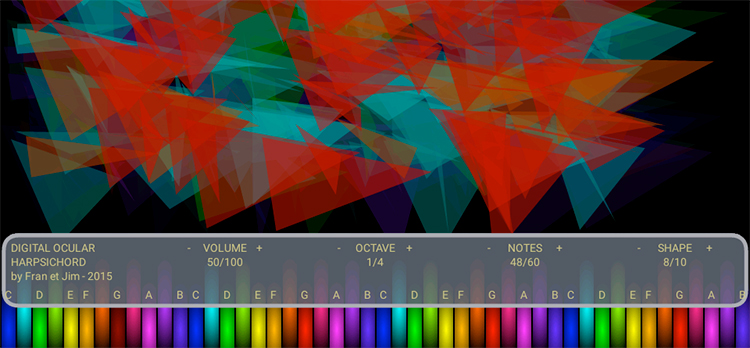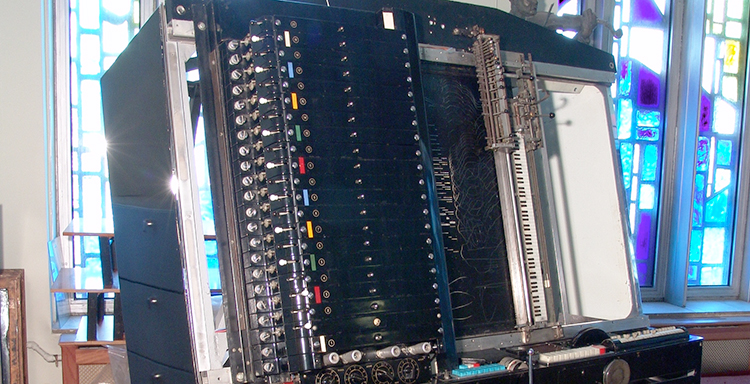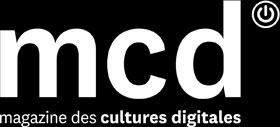or how to draw sound lines
Whenever we describe music, outside of its technical aspects, we quickly revert to a physical, geographical, landscape vocabulary. Is strictly musical rhetoric insufficient, or does there exist an intimate relationship between sound and image that makes such comparisons inevitable? Here is a subjective and necessarily incomplete overview of synesthetic musical pieces.

Jean-Michel Rolland, clavecin oculaire numérique conçu d’après les écrits du père Castel de 1735. Photo: D.R.
In February 1809, Ernst Florens Chladni was invited to the Tuileries palace by Napoleon Bonaparte. The German physician and musician came to present to him his extraordinary invention, or rather his discovery, which all the courts in Europe were talking about. Spurred by his curiosity and love for sound, in 1787 this father of modern acoustics had done an experiment in which he sprinkled some sand on a metal plate and rubbed it with a bow. Depending on the location, length and frequency of the resulting sounds, geometric shapes appeared, disappeared and transformed, offering the marvelous spectacle of music becoming lines.
It was no coincidence that this discovery rose to fame at the height of German romanticism, when appreciation for analogies between various resonances of the world was already setting the stage for another movement to appear a good century later: surrealism. At that time, romanticism aimed ideally to synthesize the arts. Meanwhile, shining a light on these intimate relationships between sound and image fit right into the Zeitgeist of the budding 18th century.
More than 150 years later, another scientist, Hans Jenny, expanded on Chladni’s experiments by placing oscillators on quartz sand, as well as on fluids. Jenny described the resulting cymatics—acoustic shapes—as following orderly patterns. Surprising images, reacting immediately to the sound, formed in the powders, but also in water, in alcohol. They could only be referred to, without hyperbole, as sound images.
Henceforth, the correlations between the harmony of sounds and the harmony of lines were scientifically, physically, confirmed. But it didn’t take these two ingenious installations for people to make images from every flutter of sound. Every description of music sooner or later uses a landscape vocabulary. How many skies, waves, sands, branches do we hear in the humming of strings, in the drops of a piano, in the vibrations of a synthesizer, in the friction of metal…
Still others feel this link intimately, and the complicity between image and sound stems from deep within, at the very root of their perceptions. This phenomenon, known as synesthesia, is rare, but some people “see” sounds in certain colors, while others “hear” certain sound frequencies when they see red, blue, green…
Poetry or neurology, the senses concur to entangle seeing and hearing, from Rimbaud (Voyelles) to Kandinsky, from Baudelaire (Correspondances) to Scriabin. This last artist, a Russian composer who dreamed of a great project associating colors and music, reappropriated the ideas of Father Castel, who in the 18th century had designed an “ocular harpsichord” for the deaf, whereby the succession of colors on the eye produced the same effect as musical notes on the ear.
Such audacious attempts, not always successful, were scorned by some, admired by others. Nonetheless, the 20th century witnessed the explosion of technology, just as it welcomed creative works where music merged with other movements well beyond the musician on his instrument.
It was the age of the theremin, named after its inventor. This pioneer instrument of electronic music owed its fame not only to its sounds, or even its technology, but above all to its futuristic mode of “remote” execution, anticipating the remote sensors that surround us today. The theremin player literally manipulates space: he keeps his hand within a few feet of the antenna, which picks up his movements and converts them into sound, controlling the pitch of the note with his right hand, the volume with his left.
The instrument has lived on through the century, and far from being classified as a curiosity of music history, it can still be heard today on albums by Squaremeter, The Damned, Radiohead, Cevin Key (Skinny Puppy)…
Some artists scratch space, while others (finally) make light or colors sing. Such is the case of the laser harp, invented in 1980 by Bernard Szajner. The interrupted light beam determines the pitch. Here again, other musicians, including some very successfully, have reappropriated this synesthetic invention that owes its existence to electronic technology.
From sensors to motion capture, astonishing artworks are expanding the field of musical possibilities. We have only to see the manipulating musicians of Biomuse, led by Atau Tanaka, as they move their arms like conductors of an invisible orchestra to knead a subjugated texture from this ghost ensemble. Biomuse, the fruit of much labor by researchers Hugh Lusted and Benjamin Knapp at BioControl Systems, is a “biomusical” interface that senses electric energy in the forearms and converts its movement and tension into sounds and music.
BioMuse Trio, in which Ben Knapp wears the biosensors, with violonist Gascia Ouzounian and Eric Lyon on laptop, gives an example of the installation’s fantastic dynamic, playing off violin samples captured digitally in almost real-time. Gestures trigger the imagination as if engraving on emptiness. Theremin, laser harp, Biomuse: the avatars of these spatial arm gestures all have the same objective, no matter their degree of sophistication: to transgress a law of physics, where one must touch in order to provoke…
Much more adventurous was the path that extended from Father Castel’s ocular harpsichord, which Scriabin had also explored, which involved positively linking sound to image. From 1937 to 1957, the Russian engineer Evgeny Murzin developed such a device. Not only did he imagine it, he made it. The resulting ANS (in a tribute to Aleksandr Nikolaevich Scriabin) achieved the opposite of the discoveries of Chladni and Jenny—it converted images into sounds. Monumental, rustic and esoteric in appearance, this synthesizer (which Ivan Pavlov of CoH described as a “cross between a time machine from the future and a magic, antique, mysterious engine”) embodied a two-way concept: when played, the ANS could produce drawings and lines corresponding to sound data, like “musical landscapes” painted by the musician; but it could also react musically by synthesizing a sound from its graphical representation. The graphic was drawn on glass plates coated in black resin that were slid into the device, which reacted as programmed with purely synesthetic momentum.
There is only one ANS left today, conserved in Moscow at the Museum of Music, and has long been presented by Stanislas Kreichi, former assistant of Murzin. Little by little, the machine sweeps across the engraved glass plate, instantly converting lines into music, assimilating the stack of prepared drawings to a musical score.

Le synthétiseur ANS conçu par l’ingénieur russe Yevgeny Murzin. Photo: D.R.
In short, thanks to the ANS, shapes “take sound” in the same way that the discoveries of Chladni gave shape to sounds. Artemiev (for the soundtrack to Tarkovski’s Solaris), A. Schnikte, Coil and Cisfinitum have all used ANS sounds that seem to have emerged from the cosmos in the form of an austere chant full of light. The coldness of space, which we admittedly associate with Soviet epics, draws a halo around the delicate humming of the machine, its fragile whistling, and its medium waves.
Indeed, the music of the ANS is astonishing in its process; it is also unheard of (both literally and figuratively) in its texture. The Coil box set of 3 CDs and 1 DVD, which revisits the group’s 2002 experiments with the Russian synthesizer, gives a wide panorama of the machine’s potential.
The ANS made a dream come true: instantly converting drawing into musical vibration. It was a triumph of the romantic spirit, of surrealist audacity over realistic rigidity. Each step of this importance pushes back further the limits of the impossible. Just yesterday, a synesthetic device such as the ANS seemed crazy. Before that, space travel was only a fantasy. We know the giant step that mankind has made since… Space, and why not time? Maybe it’s the next phase. And we can only dream when we consider what Nobel prize-winning physician Georges Charpak very seriously suggested, that the ancient vibration of sounds emitted by a potter of antiquity could have engraved the pot as it spun, like grooves on a record made of wax or vinyl (1). If the future has yet to be written, the past is still overflowing with treasures to decode…
Denis Boyer
published in MCD #70, “Echo / System : music and sound art”, march / may 2013
Denis Boyer is Editor-in-chief of the review Fear Drop > www.feardrop.net
(1) These “paleo-acoustics” (or archeoacoustics) follow the research of Richard Woodbridge, who had done four such experiments in 1969. The first succeeded in transcribing a sound precisely produced by the spin of a potter’s wheel on a piece of pottery. This sound could be reproduced through headphones with the help of a wooden tip and a piezoelectric cell.






